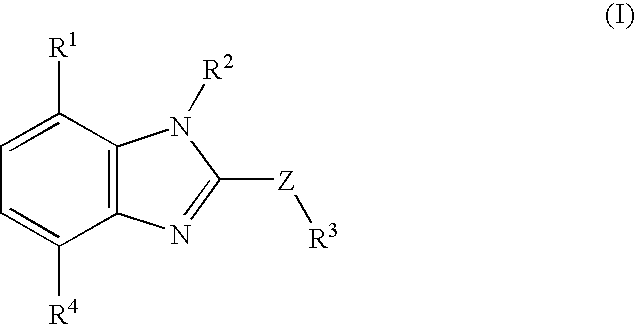Benzimidazole compounds
a technology of benzimidazole and compounds, applied in the field of benzimidazole compounds, can solve the problems of low utility value of peptide derivatives as medicines and abnormality in the living body response system, and achieve the effect of promoting the reaction
- Summary
- Abstract
- Description
- Claims
- Application Information
AI Technical Summary
Benefits of technology
Problems solved by technology
Method used
Image
Examples
reference example 1
2-Amino-4,6-dichlorophenol
[0477]To a suspension of 2,4-dichloro-6-nitrophenol (60.0 g, 288 mmol) in ethanol (250 mL) and water (250 mL) was added portionwise sodium hydrosulfite (251 g, 1.44 mmol). The mixture was stirred at 65° C. for 4 h. The mixture was concentrated in vacuo, diluted with saturated aqueous sodium hydrogen carbonate solution (500 mL), extracted with ethyl acetate (200 mL×4) and washed with brine. The organic layer was dried over anhydrous magnesium sulfate, filtered, and concentrated in vacuo. The residue was purified by flash column chromatography on silica gel eluting with a 0-50% ethyl acetate / n-hexane gradient mixture. The filtrate was concentrated in vacuo to give the solid, which was washed with n-hexane to give the title compound (30.6 g, 172 mmol, 60%) as a colorless powder.
[0478]1H NMR (CDCl3) δ 3.92 (s, 2H), 5.36 (s, 1H), 6.59 (d, J=2.1 Hz, 1H), 6.71 (d, J=2.1 Hz, 1H).
[0479]MS Calcd.: 177; MS Found: 178 (M+H).
reference example 2
2,4-Dichloro-6-(dimethylamino)phenol
[0480]To a suspension of 2-amino-4,6-dichlorophenol (25.0 g, 140 mmol) in acetonitrile (300 mL) were added formaldehyde (36-38% solution in water; 110 mL), sodium cyanoborohydride (26.1 g, 415 mmol) and acetic acid (6.0 mL). The mixture was stirred at 0° C. for 2 h. The mixture was diluted with saturated aqueous sodium hydrogen carbonate solution (400 mL), concentrated in vacuo, and extracted with ethyl acetate (300 mL×3). The combined organic layer was washed with brine, dried over anhydrous magnesium sulfate, filtered and concentrated in vacuo. The residue was purified by flash column chromatography on silica gel eluting with a 5-20% ethyl acetate / n-hexane gradient mixture. The filtrate was concentrated in vacuo to give the solid, which was recrystallized from diisopropyl ether-n-hexane to give the title compound (18.5 g, 89.7 mmol, 64%) as colorless crystals.
[0481]1H NMR (CDCl3) δ 2.67 (s, 6H), 6.60 (brs, 1H), 6.98 (d, J=2.7 Hz, 1H), 7.09 (d, J...
reference example 3
4-Chloro-2-(dimethylamino)phenol
[0483]The title compound was prepared from 2-amino-4-chlorophenol in the similar method described in Reference example 2.
[0484]1H NMR (CDCl3) δ 2.63 (s, 6H), 5.01 (s, 1H), 6.85 (d, J=8.4 Hz, 1H), 7.00 (dd, J=2.1 Hz, 8.4 Hz, 1H), 7.10 (d, J=2.1 Hz, 1H).
[0485]MS Calcd.: 171; MS Found: 172 (M+H).
PUM
| Property | Measurement | Unit |
|---|---|---|
| temperature | aaaaa | aaaaa |
| temperature | aaaaa | aaaaa |
| temperature | aaaaa | aaaaa |
Abstract
Description
Claims
Application Information
 Login to View More
Login to View More - R&D
- Intellectual Property
- Life Sciences
- Materials
- Tech Scout
- Unparalleled Data Quality
- Higher Quality Content
- 60% Fewer Hallucinations
Browse by: Latest US Patents, China's latest patents, Technical Efficacy Thesaurus, Application Domain, Technology Topic, Popular Technical Reports.
© 2025 PatSnap. All rights reserved.Legal|Privacy policy|Modern Slavery Act Transparency Statement|Sitemap|About US| Contact US: help@patsnap.com



